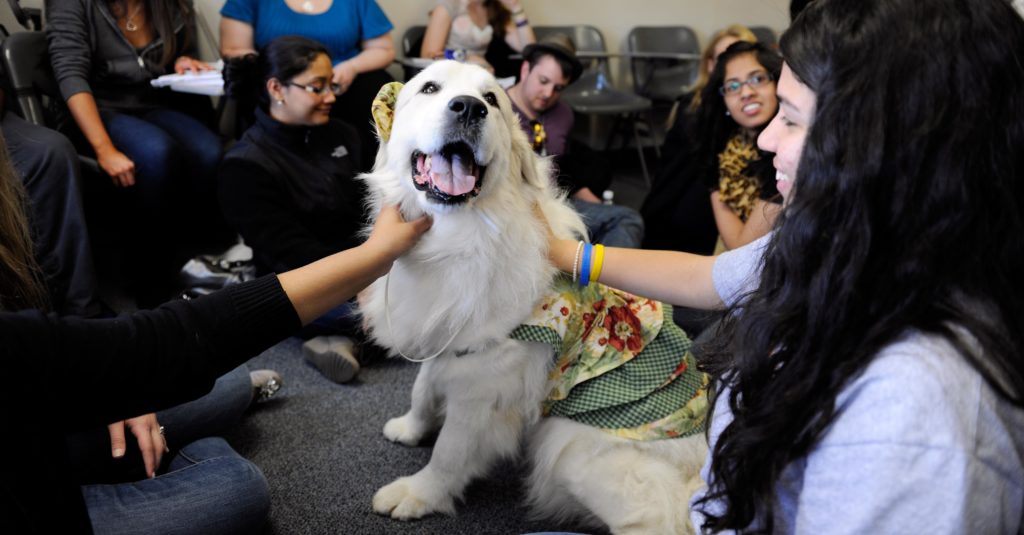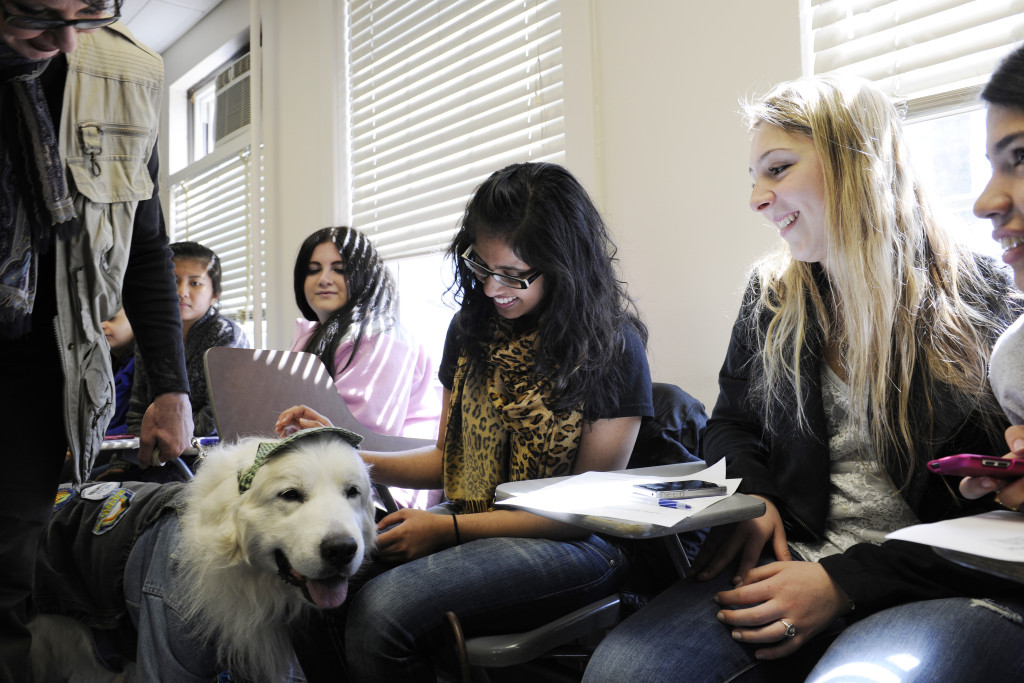
There’s no doubt that a dog can make a person’s day better. From a study proving that looking into a dog’s eyes produces the same oxytocin that’s produced when you look at someone you love, to a study showing that looking at cute puppy pictures can make you more productive at work, the evidence is there.
And there is also no doubt that many students are under stress. Regardless of school age, kids may be dealing with learning disabilities, bad home environments, peer pressure, or even just stressed with school and the prospect of the future. These stresses can cause kids to have a hard time with their studies and even just interacting with other human beings.
Enter the dog
While kids are sometimes reluctant to speak with another human about their problems, a dog seems to be easy. Most kids have no problem opening up to a furry friend, who they know can’t judge them or yell at them.
So why not have them in schools? O’Farrell Charter School in San Diego, California and Northern Highlands Regional High School in Allendale, New Jersey are two schools that have already implemented therapy dogs into everyday life for their kids, with amazing results. (Interestingly, the dog at O’Farrell is not a certified therapy dog, though she has had extensive training).

Frontrunner Learning Centres in Sidney, Australia is an after school tutoring program. Part of their work includes assessing children who may have learning problems and then developing strategies to teach them.

The Centre opened twenty years ago, and they have been having dogs present during lessons for much of that time.
“Our experience is best exemplified by the presence of our beloved (but no longer with us), miniature black poodle, Leo. Leo was a gentle, loving dog that seemed to understand children very well. Unlike most small dogs, he loved children – as long as they were not overly boisterous. One day, a new child started at our practice and, being slightly behind in developmental stages, this 7 year old cried when mum left the office. To put the child at ease, we put him on a computer activity so he could relax. In the meantime, I brought a chair close to the child and called for Leo. He came and, on command, jumped onto the spare chair. I asked the boy to look after Leo for me by patting him while doing the computer work. Within moments, the boy’s cries had become minor sobs while he worked the computer keyboard with his left hand while patting Leo with his right. A few minutes later, he was happily working on the computer with Leo on his lap. This child loved our tutoring and was happy to come because Leo had made lessons better for him.” – Martin Marszal, Director Frontrunner Learning Centres.
Marszal says it’s not unusual to have kids insist on having a dog near them while working.

“It seems that children, like adults, are more relaxed, more easily taught, when there are pets around,” he adds.
The centers also play baroque music in the background. We get complaints about the music, never about the dogs, he says.

Teaching Healing Through Dogs
On the other side of things, Diane Dembicki, PhD, LMT, CYT is a clinical associate professor and director of the MS in nutrition program at Adelphi University in Garden City, New York. She teaches a course, NUR357 Healing and the Arts, which focuses on a different approach to healing therapies – spanning from expressive and visual arts and drama therapy, to dance and music therapy (www.events.adelhpi.edu)
One of the therapies she includes – is dog therapy.
“I decided to include therapy dogs because my PhD research, which was published, was on how pets affect health and I am also a pet lover (own two rescue cats and a rescue dog and do weekly volunteer work at my local animal shelter). Then a student in the very first class, a nurse (in the RN to BSN program, already working in a hospital), learned of what I did and said she knew of someone who visited the hospital with therapy dogs, and I made that contact–Susie Wong–Susie and I became fast friends the moment we met and she has been coming with her therapy dogs to my two sections each and every semester.” – Dr. Dembicki
Susie Wong raises and trains Great Pyrenees for therapy work. It is her dogs that come to Dr. Dembicki’s class each semester.

And while the class may be geared toward teaching kids alternative therapy techniques to use as nurses, it’s an elective course so Dr. Dembicki gets students from all majors, including psychology, sociology, speech disorders, business, and various sciences. The class fills up the day registration opens, and there is always a waiting list.
“It is just amazing the effect those dogs have on the students–Susie and the dogs walk into the classroom and there ooohs and aaaahs and smiles all around for the entire 90 minutes or so that they are there. Even students that were a little leery of large dogs (Great Pyrenees are like small ponies)–and it is optional to interactive but they are asked to at least observe–are soon laying on the floor with the dogs. The purpose is to learn about therapy dogs and the effect they have on people by experiencing it themselves–this is experiential–and the students become very de-stressed because they report that. They also need to write on “therapeutic presence” that dogs do but people can do also and how that helps heal people (we don’t mean cure, there are many forms of healing, as the students learn).” – Dr. Dembicki.
The below video explains in more detail about Dr. Dembicki’s amazing class. I don’t know about you, but it makes me want to go to Adelphi just to take this class!
Cons
Of course, there are things to think about when you bring a dog into a place such as a school. There are allergies, for example and some kids, as both Dr. Dembicki and Marszal mentioned to me, are afraid of dogs.
Marszal explains that in his area, there is a large population of migrants, many of whom are from cultures that do not have the same type of pet culture they have in Australia (they have more pets in Australia than almost anywhere else in the world, he says).
“Indeed, some of my clients are afraid of dogs,” Marszal explains. “At least, until they get used to having a border collie, a papillon or a standard poodle hanging around. The students show a great deal of concern for the dogs and are disappointed if there is no dog present that day.”
There are cultures were dogs are considered dirty and even dangerous, so some kids and/or their parents, may resist a program that allows a dog on campus. Plus, there is the danger of bites, and bacteria such as giardia can be passed from dog to child if sanitation standards are not kept up. However, if the dog and handler team are trained (as they should be) these risks should be low.
Tell Us What YOU Think About Therapy Dogs At School?

